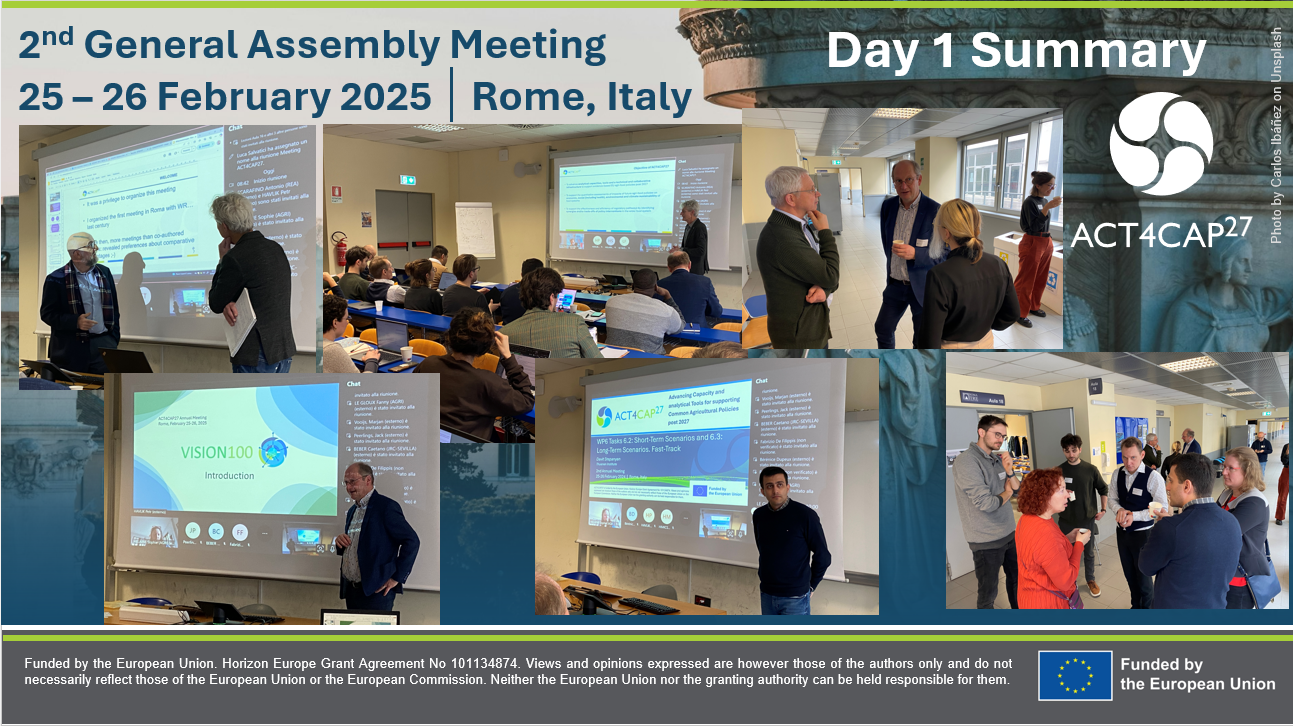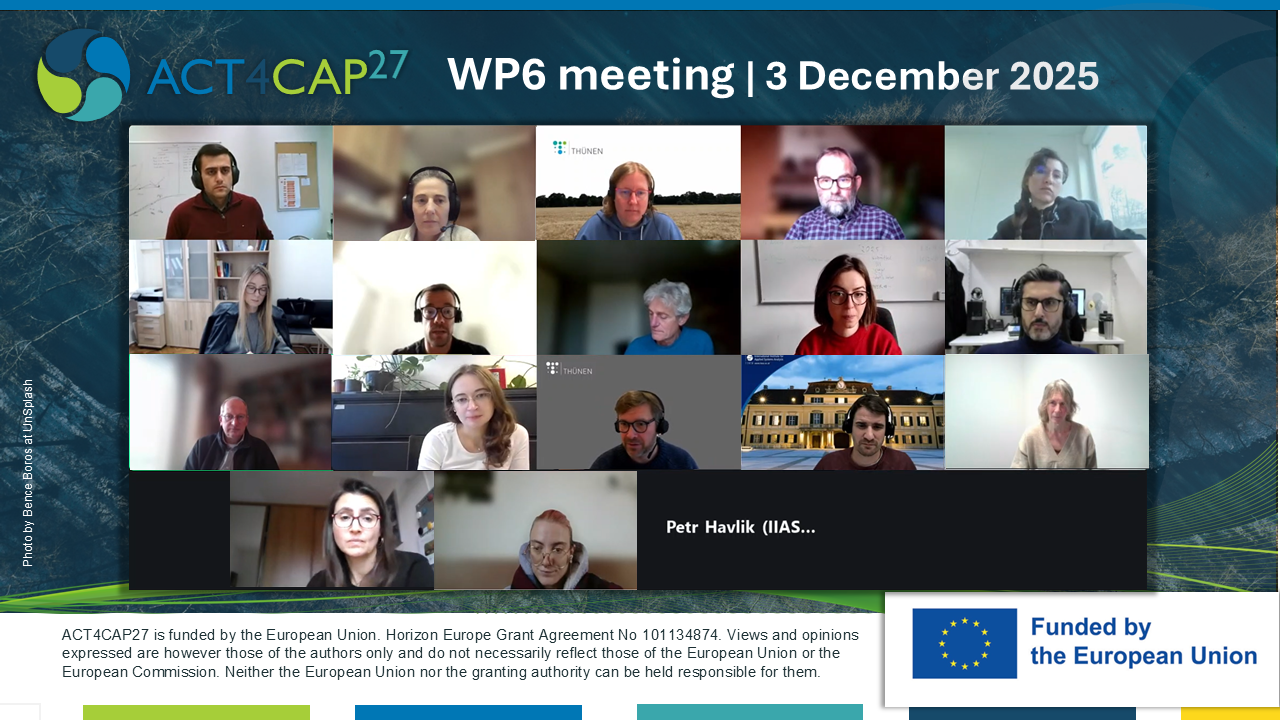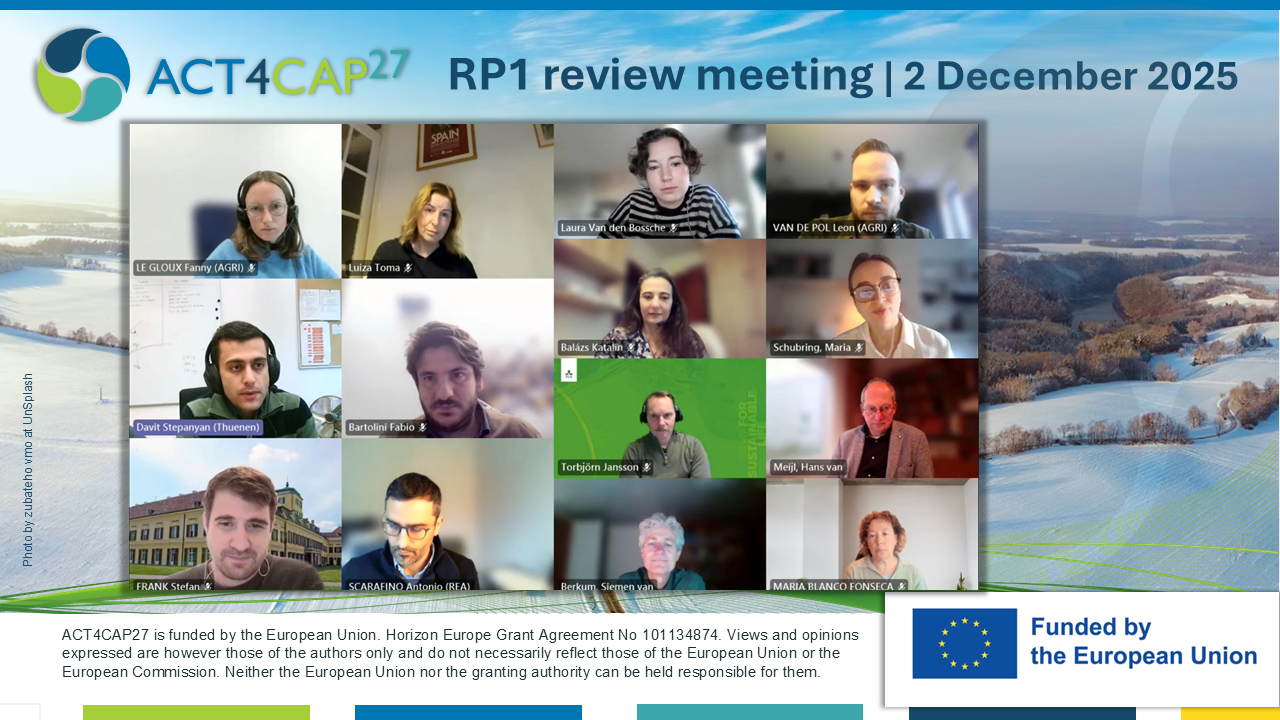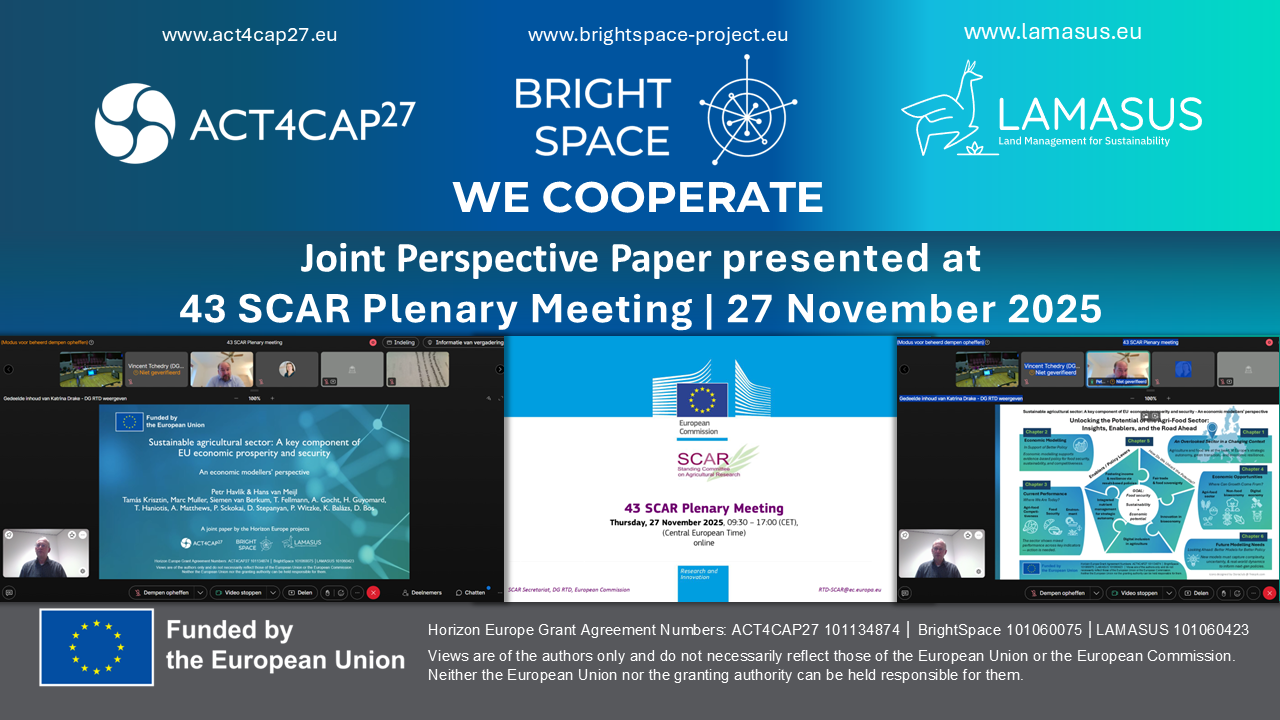At the ACT4CAP27 2nd Annual Meeting (25-26 February 2025, Rome), Luca Salvatici welcomed participants on behalf of the UniRoma3 team, and project coordinator Siemen van Berkum outlined the meeting’s objectives and agenda. The focus was on advancing analytical capacities, tools, and collaboration to support evidence-based EU agri-food policies post-2027. Key priorities included enhancing quantitative impact assessments of future policies on economic, social, environmental, and climate sustainability, improving regulatory effectiveness by identifying policy synergies and trade-offs, and ensuring ACT4CAP27 remains relevant in the evolving research and political landscape. Discussions also covered key deliverables, including the conceptual framework, model innovations, capacity building, and stakeholder engagement strategies.
Sophie Helaine, Head of Unit at DG AGRI (AGRI.A.3 – Policy Performance) and member of the ACT4CAP27 Scientific and Policy Advisory Board, presented the EU’s Vision for Agriculture and Food. She emphasized the need for a resilient, competitive, sustainable, and fair agri-food system that attracts future generations while addressing geopolitical tensions, climate change, and structural challenges like generational renewal. The vision for 2040 focuses on ensuring fair farmer incomes, strengthening food system resilience, and integrating sustainability while fostering fair working conditions and vibrant rural areas. The approach is based on bottom-up dialogue, recognizing agriculture’s strategic role, and tailoring policies to diverse regional needs rather than applying a one-size-fits-all approach. Key priority areas include making farming more attractive through fairer incomes and investment in entrepreneurial opportunities, enhancing global competitiveness and risk management, promoting climate-friendly practices, and strengthening rural communities. Actions include revising the Unfair Trading Practices Directive, simplifying CAP, expanding carbon farming, and supporting digitalization and innovation. The CAP’s future will focus on targeted support for active farmers, young farmers, and small and medium-sized farms, ensuring fairer competition globally, and aligning EU and import standards on pesticides and animal welfare. The upcoming Vision Conference in May 2025 will continue shaping an attractive and sustainable EU farming and food sector.
Hans van Meijl (WSER) and Petr Havlik (IIASA) presented Vision100, a joint initiative of the LAMASUS, BrightSpace, and ACT4CAP27 projects. Vision100 aims to define the role of the EU agri-food sector in addressing Europe’s economic and environmental challenges, ensuring competitiveness, sustainability, and food security. A key output is a position paper (10-20 pages) that will provide insights from decades of model-based policy impact assessment, guiding scenario frameworks across projects and avoiding duplication. Vision100 follows a triple F approach—Fast (aligned with the European Commission’s timeline), Furious (bold and innovative), and Focused (prioritizing 3-4 critical topics). The process includes a core group kickoff in December, a draft by February 28, 2025, and final publication by March 31, 2025. The paper will cover competitiveness, environment, and food security, outlining key contributions, future priorities, and necessary policy measures, based on model-based evidence from the participating projects.
At the ACT4CAP27 Annual Meeting, Davit Stepanyan (Thuenen Institute) presented WP6 Tasks 6.2 and 6.3, outlining the short-term (Fast-Track) and long-term (Final Track) scenario assessments for EU agri-food policies post-2027. The Fast-Track assessment (M24 – February 2026) focuses on identifying modelling gaps and developing scenario narratives on Ukraine’s accession, biodiversity futures, health & nutrition (e.g., sugar tax), and strategic dialogue on the CAP. The Final Track assessment (M60 – February 2029) will provide a more in-depth evaluation, ensuring robust policy analysis and alignment with CAP and Green Deal objectives.
Siemen van Berkum and Saeed Moghayer (WSER) presented WP1.1/1.2, outlining an operational framework for analyzing food system outcomes. They emphasized a food systems approach, recognizing the interconnectedness of environmental, economic, and social factors, as well as feedback loops between actors, markets, and external drivers. The framework highlights the need for new metrics to assess sustainability (including social and economic dimensions) and agency (people’s ability to make informed food choices). A comprehensive monitoring system with robust indicators is crucial for evaluating policy interventions and ensuring that EU Green Deal (EGD) and CAP targets are met without unintended consequences. Further research is needed to strengthen impact assessments and expand indicators in the EU Food System Dashboard to better capture sustainability transitions.
Verena Laquai and Karen Arcia (Thünen Institute) presented WP1 T1.3 D1.2, focusing on CAP post-2027 policies, model gaps, and scenario identification for sustainable food systems analysis. The report aims to assess potential CAP reforms (2028-2034), modelling limitations, and future research directions. Key tasks include a policy analysis of CAP’s functioning, expected changes, and external drivers (e.g., geopolitical shifts, technological advances, trade disruptions). It also examines gaps in current modelling frameworks (AGMEMOD, CAPRI, GLOBIOM, MAGNET), identifying limitations in depicting CAP’s sustainability objectives and interactions with other EU policies (EGD, F2F, BS2030). The proposal outlines improvements for future CAP modelling, including new indicators, scenario frameworks, and better integration of policy trade-offs. The work is aligned with WP6 and other ACT4CAP27 components, with a final report expected by February 2026.
Rupesh Singh, Stefan Frank, and Petr Havlik (IIASA) presented the ACT4CAP27 Portal, focusing on database, data processing modules, and the computational framework. Task 4.1 involves building a centralized database to monitor and assess EU food system sustainability, automate data processing for WP2/3 models, and ensure up-to-date calibration and validation. Task 4.2 develops a Computational Framework to integrate and execute various open-access modules, providing seamless data orchestration, model interoperability, and scenario quantification. IIASA is leading IT infrastructure development, ensuring cloud-based scalable storage, role-based access control, data validation, and API access. The framework also includes a Model Repository for storing and linking models via GitHub/GitLab, enabling modular coupling, workflow automation, and scenario exploration with real-time visualization tools. This system streamlines data processing, facilitates model collaboration, and enhances policy scenario analysis for CAP and food system sustainability.
Marco Springmann and Maria Schubring (UCL) presented the Health Assessment Model, which evaluates the health burden of diets and their links to food system policies. They highlighted that imbalanced diets contribute to one in four premature deaths worldwide, with risks such as low fruit, vegetable, and whole grain intake, as well as high consumption of red and processed meat. The model assesses dietary impacts on coronary heart disease, stroke, type 2 diabetes, and cancer, using comparative risk assessment methods. They demonstrated applications in evaluating dietary recommendations (EAT-Lancet), GHG taxes on food, agricultural subsidy reforms, and VAT reforms, showing how policy changes influence both health outcomes and economic welfare. The model links food system models with health impacts by mapping dietary and weight-related risks, allowing direct data integration or scenario-based proportional changes. Discussion points included the level of detail needed for model linkage, baseline data requirements, and next steps to refine and illustrate assessments in case studies.
WP2 T2.2 Environmental Assessment Modules were presented and discussed, showcasing a modular system that integrates environmental impact assessments with economic models (MAGNET, CAPRI, GLOBIOM, AGMEMOD). The modules quantify key environmental indicators, including GHG emissions, air pollution, water pollution, and biodiversity loss, using data from global sources like FAOSTAT and UNFCCC. The biodiversity module downscales land-use changes to assess ecosystem impacts, while the water quality model (SWAT+) evaluates nitrogen and phosphorus pollution in various European watersheds. A GHG emissions module estimates farm-gate emissions, focusing on agricultural production processes. The SIMPLE-G model was discussed as a tool for assessing decarbonization strategies in agriculture, considering land use, fertilizer use, livestock management, and trade-related emissions. The session emphasized the need for standardized data formats, linking scripts, and automated workflows via an Accelerator Platform to ensure seamless integration across models. Key discussion points included the relevance of emission coefficients, completeness of GHG categories, and linking emissions data with trade flows to assess global supply chain impacts. Next steps involve refining methodologies, adding management practices, and running policy scenarios to enhance the accuracy and applicability of environmental assessments.
WP2 T2.3 Socio-Economic Assessment Module was presented by Michiel van Dijk (WSER), focusing on integrating socio-economic indicators into the MAGNET CGE model. The module refines and harmonizes indicators to assess CAP performance, covering employment, wages, food affordability, and income distribution. Labour market projections are based on GTAP/MAGNET databases, incorporating occupation-specific employment trends aligned with SSPs and ILO data. Key indicators include real disposable wages, farm-nonfarm wage gaps, wage-based Palma ratio, and food affordability measures. A microsimulation approach links MAGNET’s wage and price projections with EU household survey data (SILC & HBS) to model income and food consumption distribution at the (sub)national level. Next steps include validating employment indicators, documenting methodologies, finalizing country pilots, and integrating the module into ACT4CAP. Additionally, plans involve enhancing Global Value Chain and Food Security modules in collaboration with UNIROMA3 and Thünen to improve economic assessments within the agri-food system.
Hans van Meijl summarized Day 1, highlighting key discussions. Day 2 will focus on Task 5.4 Capacity Building and the Young Researchers Network, along with rotating sessions exploring innovations in model structures to better represent EU food systems and sustainability policies (WP3). Additional discussions will cover stakeholder engagement (WP7T7.1), communication, dissemination, and exploitation strategies (WP7T7.2), as well as project management updates and the roadmap to the interim report due in August 2025.




